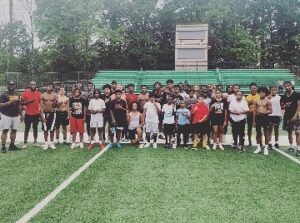A chart that recently went viral on the Internet showing that 42 of the 47 athletes coach Urban Meyer has recruited to Ohio State played multiple sports in high school has brought great attention to an ever-present question on high school campuses.
Play all the sports you want, or narrow your focus on the one you want to play at the next level?
When a three-time national championship-winning coach gives a glimpse of his personal recruiting strategies, it carries a lot of weight.
While there has been a shift in recent years from a parental perspective, and from specialty trainers offering athletes the ability to emphasize one sport year-round, Meyer’s idea that a multi-sport athlete tends to excel when he hones his focus on football in college is not new.
“Our goal from an evaluator standpoint was that you wanted to see them do something competitive with your own eyes,” said former Oklahoma State coach Pat Jones, who coached at the college level from 1975-1994. “So that might have to be another sport. In states where you didn’t have spring football, you’d have to go watch a kid play baseball or run track.
“And it helps a kid to stay on his toes and keep on edge from a competitive standpoint year-round.”
Training opportunities are more abundant and specific than they’ve ever been. And many athletes are choosing that route, hoping to sharpen their skills to be at their maximum level when college recruiters come around. And the benefits of such training are greater than they’ve ever been.
College coaches aren’t turned off by a one-sport star, but a multi-sport player has more than one platform to present his skills.
The story of Oklahoma coach Bob Stoops’ first encounter with running back DeMarco Murray has been told over and over, with Stoops’ interest being sparked by seeing a young Murray dunk a basketball.
Jones recalls nearly giving up on his recruitment of defensive back Chris Rockins in 1980 until he saw that Rockins had long-jumped 24 feet during track season.
Sam Bradford is Oklahoma’s patron saint of multi-sport athletes. He excelled at football, basketball, golf and hockey in high school at Putnam City North, but was considered a middle-of-the-pack recruit as a Big 12 quarterback. No one was predicting a Heisman Trophy and No. 1 overall NFL Draft choice in his future, but when he put the other sports aside, he flourished as a football player.
One caveat exists in the multi-sport benefit theory — the athlete actually needs to be playing the other sports.
“Basketball helps a football player’s feet, and track helps his explosiveness,” former PC North coach Bob Wilson said. “But if you’re gonna go ride the pine and you’re not gonna be able to contribute to that team, maybe you need to be in the weight room.”
And amid all the debate, there’s something to be said for a child having the opportunity to enjoy the high school experience.
“High school is such precious time for these guys and girls,” Tulsa defensive coordinator Bill Young said. “They need to play what they want to play. There’s plenty of time to lift weights and go to camps. But they really need to be able to enjoy those few years they’ve got in front of them as a high school student.”
Writer: Scott Wright
#SupremeAthlete

